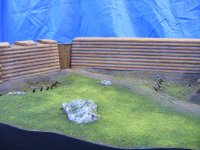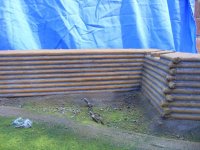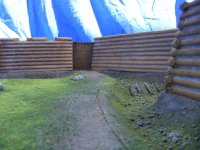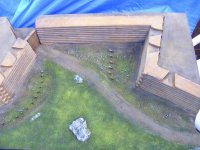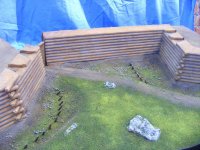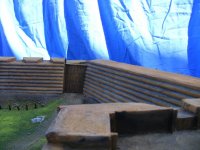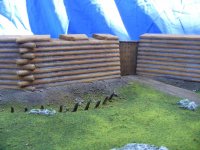You are using an out of date browser. It may not display this or other websites correctly.
You should upgrade or use an alternative browser.
You should upgrade or use an alternative browser.
Bastion Fort - French & Indian War (1 Viewer)
- Thread starter Fraxinus
- Start date
Shutters are total redo, all 72 of them, and the seam from the middle of the parade ground has been eliminated, which is huge plus (Texture fiberglass wall panel, 0,1 inch thick, but comes in 4ft x 8 ft sheets). Some improvements to the gun embrasures. Tons of small fixes to do, but no major work for the remainder of the year. There is no gate yet, but that is for 2015. Fresh vacuuming and some dusting, but really needs a good cleaning. Staying with the Risorgimento Green (Lowes Grecko Green). The backfill for the gun embrasures is Fish Tank Gravel, Polished (Pet Smart). Very clean and not dusty at all.












Last edited:
mikemiller1955
Lieutenant General
- Joined
- Aug 3, 2008
- Messages
- 17,614
Ken...
the shutters look great...
did you somehow stain over the blue paint...
or did you make 72 new ones...{eek3}
the shutters look great...
did you somehow stain over the blue paint...
or did you make 72 new ones...{eek3}
Mike,
The shutters are totally new. I thought the red painted ones were going well, but when photograph, they looked just horrible. So 72 new shutters from scratch. This time I really tried to minimize any glue globs from showing. Two coats of a minwax wood stain and then two coats of a semi-gloss polyurethane. Backing behind the shutters is a Duck Tape Fabric (Wal-Mart, Sewing Section). Perfect width match for the shutters, so very fast to apply. Then the Bards Tack-Wax.
As an aside, before applying a wood stain to the roof, I should have used a pre-stain (dumb me). This is done when you want the color across a large piece wood that you are staining to be relatively uniform and not splotchy. This would have evened out the color differences between hydrostone castings that I saw after staining. Pre-stain is a minwax product as well. Tempted to start a hydrostone block fort, but this fort still needs a bunch of fine detail work.
I haven't mastered paint applications or gluing techniques. Outside the shutters and the roofs, there is very little glue in the fort. Just thousands of nails. Except for the green paint, there is no other paint. So when I went to paint the shutters, it was new to me and it went bad, very fast.
The shutters are totally new. I thought the red painted ones were going well, but when photograph, they looked just horrible. So 72 new shutters from scratch. This time I really tried to minimize any glue globs from showing. Two coats of a minwax wood stain and then two coats of a semi-gloss polyurethane. Backing behind the shutters is a Duck Tape Fabric (Wal-Mart, Sewing Section). Perfect width match for the shutters, so very fast to apply. Then the Bards Tack-Wax.
As an aside, before applying a wood stain to the roof, I should have used a pre-stain (dumb me). This is done when you want the color across a large piece wood that you are staining to be relatively uniform and not splotchy. This would have evened out the color differences between hydrostone castings that I saw after staining. Pre-stain is a minwax product as well. Tempted to start a hydrostone block fort, but this fort still needs a bunch of fine detail work.
I haven't mastered paint applications or gluing techniques. Outside the shutters and the roofs, there is very little glue in the fort. Just thousands of nails. Except for the green paint, there is no other paint. So when I went to paint the shutters, it was new to me and it went bad, very fast.
Last edited:
mikemiller1955
Lieutenant General
- Joined
- Aug 3, 2008
- Messages
- 17,614
well.......
I know you labored over those shutter...
but they look pretty near perfect to me...
so now you're both a rivet counter and perfectionist...^&grin
are those the early stages of OCD?.........................^&grin
I know you labored over those shutter...
but they look pretty near perfect to me...
so now you're both a rivet counter and perfectionist...^&grin
are those the early stages of OCD?.........................^&grin
I have had a few questions about my model, but think the easiest way to answer them is to point to a very accurate model of the real FWH. The basement model is not intended to be a model of Fort William Henry, but blends elements from Fort William Henry and Fort Duquesne. At our scale, the basement model is "larger" than Fort Duquesne, but "smaller" than FWH. The real FWH (as depicted in the link below) is as small an artillery bastion fort that one can build without injecting serious military and design
flaws. The basement model generates defensive blind spots on the curtain walls and the bunk space is insufficient to man the fort walls. In order to meet the minimum standard and eliminate the design flaws, the basement fort would have to be 10 feet by 10 feet, bastion tip to bastion tip.
Below is a link for TM Terrain, they produced a very accurate model of the Fort William Henry. The barracks, wall lengths, wall orientations, and rampart thickness (30 feet) are very accurate. The resulting parade ground is very tight, definitely not spacious. Bunk space is at such a premium the barracks themselves are not rectangular and attempt to occupy the maximum possible space. Note the location of the barracks stairs leading to the second floor are all external to the barracks, again to maximize bunk space. The single gate to the fort is hidden from attack (on the east wall, the top of the model is not aligned to the north). The curtain wall with the gun embrasures points south. The critical gun embrasures on the west wall are missing in the model (the wrong map was used for that element of the design).
If you get to the Fort William Henry page, the middle 4 pictures open up showing a much broader image. Other commissions shown as well (Alamo, Arnhem, ....). If you go to the home page, you can now purchase a Pegasus Bridge from TM Terrain, check that out.
http://www.tmterrain.co.uk/historical-projects/
flaws. The basement model generates defensive blind spots on the curtain walls and the bunk space is insufficient to man the fort walls. In order to meet the minimum standard and eliminate the design flaws, the basement fort would have to be 10 feet by 10 feet, bastion tip to bastion tip.
Below is a link for TM Terrain, they produced a very accurate model of the Fort William Henry. The barracks, wall lengths, wall orientations, and rampart thickness (30 feet) are very accurate. The resulting parade ground is very tight, definitely not spacious. Bunk space is at such a premium the barracks themselves are not rectangular and attempt to occupy the maximum possible space. Note the location of the barracks stairs leading to the second floor are all external to the barracks, again to maximize bunk space. The single gate to the fort is hidden from attack (on the east wall, the top of the model is not aligned to the north). The curtain wall with the gun embrasures points south. The critical gun embrasures on the west wall are missing in the model (the wrong map was used for that element of the design).
If you get to the Fort William Henry page, the middle 4 pictures open up showing a much broader image. Other commissions shown as well (Alamo, Arnhem, ....). If you go to the home page, you can now purchase a Pegasus Bridge from TM Terrain, check that out.
http://www.tmterrain.co.uk/historical-projects/
Last edited:
marco55
Brigadier General
- Joined
- Feb 18, 2008
- Messages
- 11,629
The model here is for 15mm figures.I had a scale section of Fort William Henry done for28mm figures.It is not as detailed as much as the smaller version.Alas it was damaged during shipment and I have not taken the time to try and repair it.Here are a few pictures.
Mark
Mark
mikemiller1955
Lieutenant General
- Joined
- Aug 3, 2008
- Messages
- 17,614
The model here is for 15mm figures.I had a scale section of Fort William Henry done for28mm figures.It is not as detailed as much as the smaller version.Alas it was damaged during shipment and I have not taken the time to try and repair it.Here are a few pictures.
Mark
Mark...
if I can offer any advice on repairing your fort...just call me...I think you have my number...
mikemiller1955
Lieutenant General
- Joined
- Aug 3, 2008
- Messages
- 17,614
Ken...that corner section of your fort looks fantastic...you have done a great job...with the cold weather...are you putting it aside for a while now...
Users who are viewing this thread
Total: 2 (members: 0, guests: 2)


